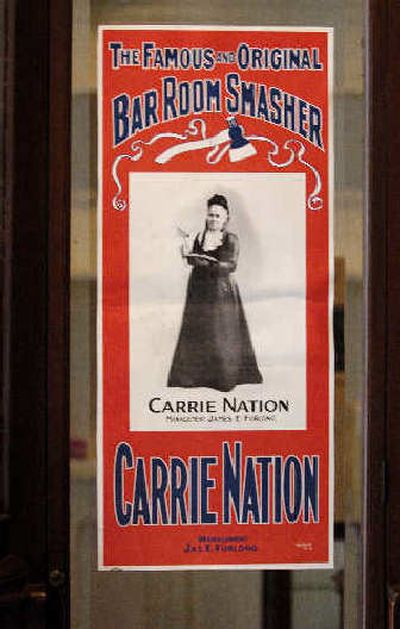New Orleans museum traces American cocktail history

NEW ORLEANS – Start with hundreds of antique liquor bottles. Add Art Deco cocktail shakers, vintage swizzle sticks and Tiki cups. Mix well. Serve inside an 1823 French Quarter town house.
The result: The Museum of the American Cocktail.
The brainchild of highbrow alcohol enthusiasts who enjoy talking and reading about liquor nearly as much as consuming it, the museum is an institution of higher mixology, complete with an annual scholarly journal, a library and monthly seminars for bartenders with a thirst for making tastier drinks.
“It’s something we’ve been talking about for years – people who are really into the cocktail and the impact the cocktail has had on American culture over the last 200 years,” says Dale DeGroff, author of the 2002 book “The Craft of the Cocktail.”
The museum opened in January, with shelves full of drinking paraphernalia plus a timeline tracing the American cocktail from the early 19th century to Prohibition to drink’s heyday in the 1930s to the cocktail revival that began in the 1990s.
But the collection needs a permanent home. Part of it is now on display on the second floor of another quirky Big Easy institution, the New Orleans Pharmacy Museum.
The founders are looking for permanent space in the French Quarter for thousands of drink-related antiques, with extra room for their library, which contains thousands of books – many from the 1800s – about drinking, bartending and drink recipes.
It’s billed as the only cocktail museum in the country. Naturally, it will have a bar. The plan is for a bartender to serve nearly forgotten drinks, such as the whiskey swizzle (rye whiskey, soda, lime juice, sugar, aromatic bitters) or the sherry twist (cocktail sherry, orange juice, Bourbon, lemon juice, Cointreau).
“It’s going to be a tourist attraction, an important part of what the French Quarter has to offer,” says DeGroff.
The exhibit begins in 1806, with the first known printed reference to the term “cocktail,” in The Balance and Columbian Repository, a Hudson, N.Y., newspaper. In response to a reader’s request, an editor defined a cocktail as “a stimulating liquor, composed of spirits of any kind, sugar, water and bitters.”
An American institution was named. Its roots were in such European drinks as punches and toddies. The liquor was Scotch, rum or gin. Other elements were a liqueur such as creme de menthe or apricot brandy, and possibly a wine: Madeira, Port or sherry.
“The people who came here from Europe, they brought with them very strong beverage traditions of their own. We basically put them all together in one glass and called it a cocktail,” DeGroff says.
Technology spurred the explosion of the cocktail’s popularity in the mid-1800s. Cheaper ice machines meant easier access to a key ingredient. So did the invention of small, reliable gas compressors that could fit behind bars and make bubbly mixers such as soda water.
In 1862, a bartender named Jerry Thomas published the first known book of mixed drink recipes; there were 10. Barman Harry Johnson published the first guide for bartenders in 1882, advising his peers to “treat all customers with the utmost politeness and respect.”
The museum’s Prohibition-era items include bottles of nonalcoholic gin – used to add flavor to acrid “bathtub gin” – and the government forms that doctors filled out to “prescribe” booze to their patients.
The exhibit, much of it from curator Ted Haigh’s private collection, brings the visitor through the Polynesian “Tiki” drink craze of the 1940s and 1950s and the “swinger” cocktail lounge in the 1960s and 1970s, complete with alcoholic board games such as “Booze It Up!”
But boozing it up is not at the top of the museum’s menu. Its founders savor their drinks but also view alcohol and its importance in history with a sober eye, from the Whiskey Rebellion to Prohibition to the demise of the three-martini lunch.
The museum treats the cocktail with respect, as the first food or drink to become famous around the world as a purely American creation, says Robert Hess, a museum founder who is a group manager at Microsoft Corp. in Seattle.
“The cocktail is approaching 200 years old now, and it’s actually fairly misunderstood,” says Hess, creator of www.drinkboy.com, a cocktail-themed Web site. “A lot of bartenders have forgotten the correct way to make them.”
The attitude sits well with New Orleans bartenders who take pride in their jobs.
“A good cocktail is all about good ingredients and using tried and true recipes. It’s not about just having drinks and slamming them down. It’s savoring something special,” says Bobby Oakes, a bartender at Arnaud’s, an upscale New Orleans restaurant.
The museum’s founders say visitors will come to learn and to drink, just as tourists flock to New Orleans cooking schools that teach Louisiana cuisine. Another trend that will help, Hess says, is the country’s growing taste for fine liquors such as single-malt Scotch and small-batch Bourbons and vodkas.
Plus, the museum should feel at home in a city that already has a boozy reputation. New York and San Francisco would have also been logical choices, DeGroff says, but New Orleans history is full of strong ties to the cocktail.
It’s the home of drinks such as the ramos fizz, the sazerac and the grasshopper. Southern Comfort was created here, as were the liqueur Herbsaint and Peychaud’s bitters, a key cocktail ingredient that’s been made in the city since the 1830s.